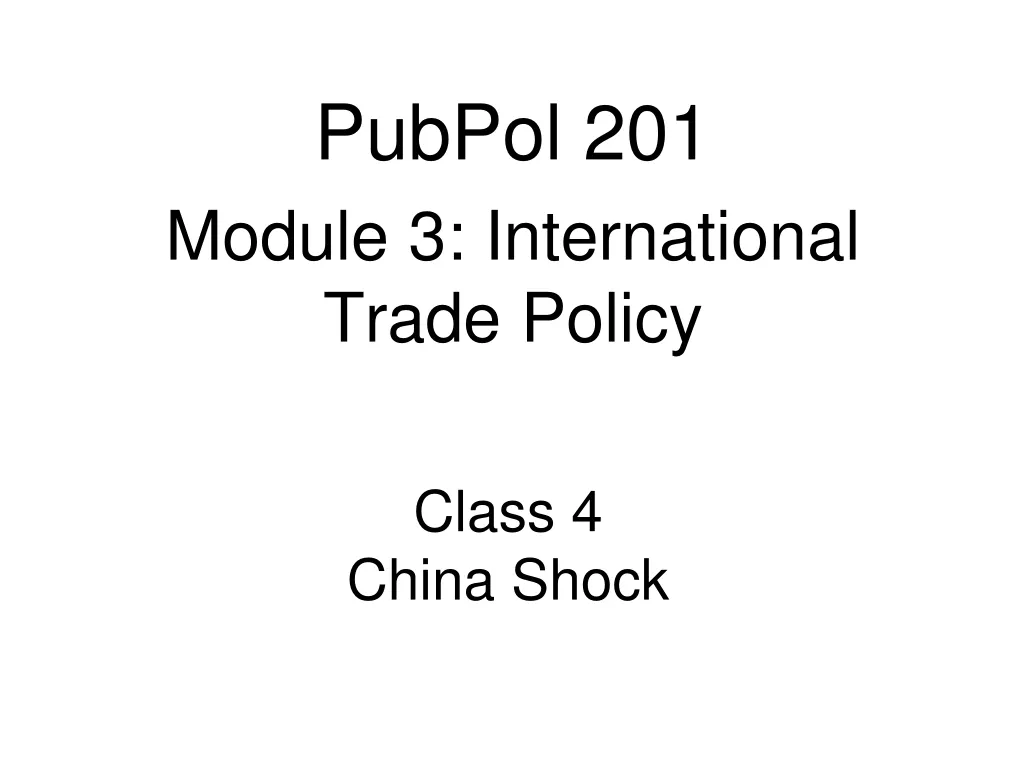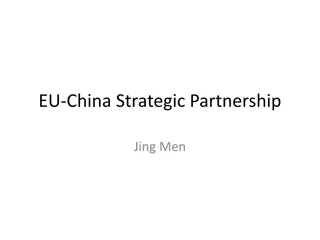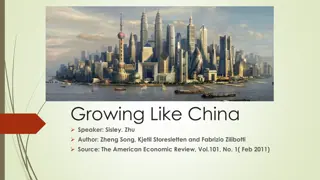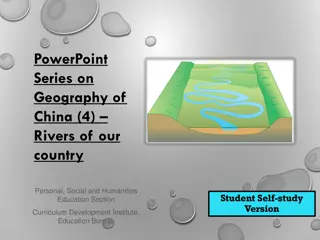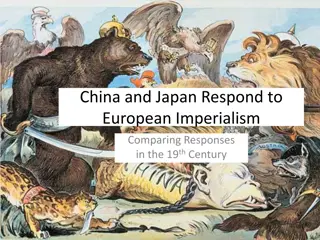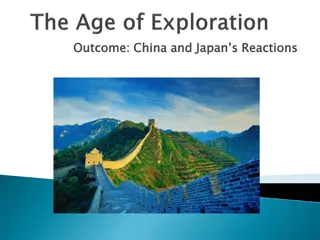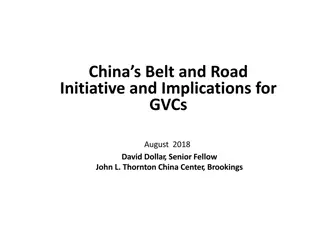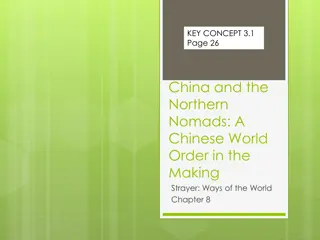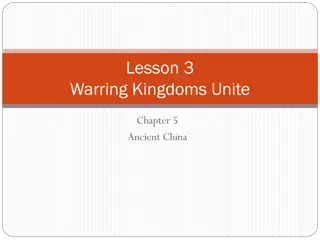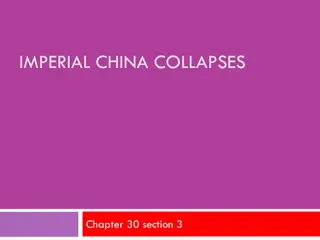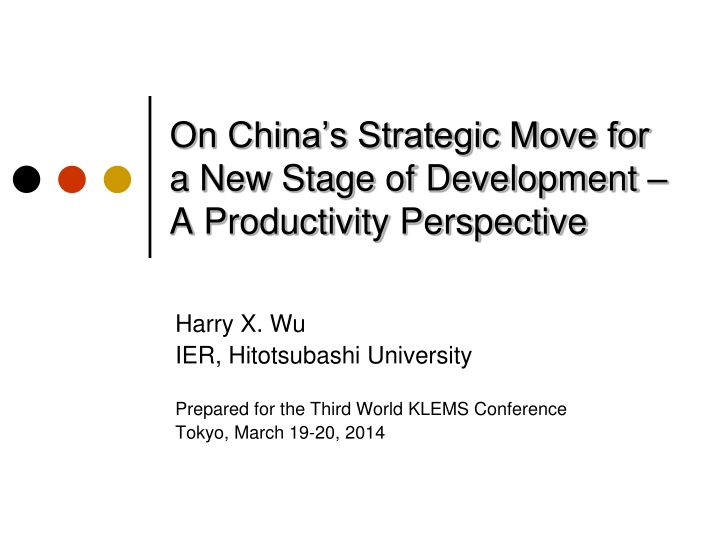
China's Strategic Move for a New Stage of Development from Productivity Perspective
China faces challenges in transitioning to a new stage of development, with issues like pollution, corruption, and income inequality. This article discusses how industry-level productivity analysis can address these problems and drive economic growth.
Download Presentation

Please find below an Image/Link to download the presentation.
The content on the website is provided AS IS for your information and personal use only. It may not be sold, licensed, or shared on other websites without obtaining consent from the author. If you encounter any issues during the download, it is possible that the publisher has removed the file from their server.
You are allowed to download the files provided on this website for personal or commercial use, subject to the condition that they are used lawfully. All files are the property of their respective owners.
The content on the website is provided AS IS for your information and personal use only. It may not be sold, licensed, or shared on other websites without obtaining consent from the author.
E N D
Presentation Transcript
On Chinas Strategic Move for a New Stage of Development A Productivity Perspective Harry X. Wu IER, Hitotsubashi University Prepared for the Third World KLEMS Conference Tokyo, March 19-20, 2014
Agenda China at the crossroads: Searching for a new stage of development Changes over the last three decades: What can we learn from the restructuring of the economy? Methodology and data Sources of the unbridled growth: How much can be attributable to productivity? Institutional problems addressed by sector-level TFP analysis Ready for overcoming the middle income trap ? China in the East Asia perspective Concluding remarks: On key challenges to Liconomics 1. 2. 3. 4. 5. 6. 7. 2 World KLEMS 3, Tokyo
1. China at Crossroads After more than three decades of unbridled economic growth, China and its new leadership now face mounting problems. It is a key challenge: cleaning up the dirty air, polluted water, and tainted food supplies, reducing corruption, and improving income inequality, which are fueling widespread discontent among the country s burgeoning middle class. Although these problems are deeply rooted in institutional deficiencies, they can also be addressed by industry-level productivity analysis. After all, the government s high growth target is pursued through government-owned or controlled industries, which has created distorted incentives and misallocation of resources. 3 World KLEMS 3, Tokyo
1. The largely government engineered growth has ensured a high speed so far but it is not yet rigorously clear if it has also improved efficiency and promoted productivity growth. We will start our exploration of efficiency problem with some important observations based on some descriptive statistics using the most recently completed industry level data for the entire Chinese economy in 1980-2010 (please refer data problems and construction in CIP papers on data in Wu 2014, Wu and Ito 2014 and Wu, Yue and Zhang 2014). The data construction follows the KLEMS methodology that is theoretically based on Jorgenson and Griliches (1967). 4 World KLEMS 3, Tokyo
1. industry grouping why it can be insightful? Despite a declining share of the state sector, the Chinese government (at all levels) has maintained strong interventions in resource allocation to maximize growth. The intervention is made industry-specific through either subsidization or administrative control or both depending on a particular industry s competitiveness and its distance from the final demand Starting from the downstream industries Local governments tend to provide subsidies (various cost-reducing measures) to local manufacturers who directly face the international market Such manufacturers produce finished and semi-finished products. The subsidized is to more quickly reap the benefit of China s comparative advantage in labor-intensive industries. Since the subsidies do not come with administrative intervention in business decision, these industries should be more efficient 5
1. grouping There are various costs underpaid by downstream industries (Huang & Tao, 2010), of which the cost of energy is one of the most important inputs produced by upstream industries. They are much further away from the end market and do not conform to comparative advantage but deemed strategically important by the central authorities. These industries not only receive subsidies in the form of public resources, but are also subject to administrative controls, hence less efficient. Now, we see a kind of cross subsidization in the production chain The downstream industries are subsidized by cheaper energy and some primary inputs produced by the upstream industries. In turn, more revenues collected from more competitive downstream industries are used to subsidize the upstream industries that are now proved more important for the downstream to generate revenues and create jobs 6 World KLEMS 3, Tokyo
The Research Problem Upstream industries also include those providing infrastructures and government services Most of the energy industries and some of the major primary input materials industries are state owned or controlled. An examination of their productivity performance compared with downstream industries will shed important light on the problem of structural distortion and misallocation of resources. The key to sustaining the cross subsidization game is both the growth and the productivity of down-stream SF&F industries. This follows that the inefficient upstream industries can be tolerated before the down-stream industries are finally established and become efficient enough without subsidies. Appendix for the grouping 7 World KLEMS 3, Tokyo
Appendix: Industry grouping (for structural distortion analysis) 2 CLM 3 PTM 4 MEM 5 NMM 6 F&B 7 TBC 8 TEX 9 WEA 10 LEA 11 W&F 12 P&P 13 PET 14 CHE 15 R&P 16 BUI 17 MET 18 MEP 19 MCH 20 TRS 21 ELE 22 ICT 23 INS 24 OTH 25 UTL Coal mining Oil and gas extraction Metal mining Non-metallic minerals mining Food and kindred products Tobacco products Textile mill products Apparel and other textile products Leather and leather products Saw mill products, furniture, fixtures Paper products, printing & publishing Petroleum and coal products Chemicals and allied products Rubber and plastics products Stone, clay, and glass products Primary & fabricated metal industries Metal products (excl. rolling products) Industrial machinery and equipment Motor vehicles & other transp. Equip. Electric equipment Electronic and telecomminucation equi. Finished Instruments and office equipment Miscellaneous manufacturing industries ?? Power, steam, gas and tap water supply Energy Energy C&P C&P Finished ?? C&P Finished Finished ?? C&P Energy C&P Finished C&P C&P Semi-finished Semi-finished Semi-finished Semi-finished 1 AGR Agriculture Agriculture 26 CON 27 SAL 28 HOT 29 T&S 30 P&T 31 FIN 32 REA 33 BUS 34 ADM 35 EDU 36 HEA 37 SER Construction Wholesale and Retail Trades Hotels and Restaurants Transport and Storage Post and Telecommunications Financial Intermediation Real Estate Activities Business Services Public Administration and Defense Non-market Education Health and Social Security Other Services Market 2 Market 2 Market 2 Market 1 Market 1 Market 1 Market 2 Market 2 Non-market Non-market ?? Semi-finished World KLEMS 3, Tokyo Energy 8
2. Changes in the last three decades VA (% p.a.) official estimates, supper fast, more than EA at the same stage (8.5- 8.8%) Hours (% p.a.) adjusted for a structural break and informal sector employment Net K (% p.a.) constructed The growth is apparently investment driven Only the export- oriented semi-finished & finished goods group is different 9 World KLEMS 3, Tokyo
2 by industry group 10 World KLEMS 3, Tokyo
2 structural changes Agriculture declines significantly, though still took one-third of total employment In industry only SF&F increased share in VA and H, but not in K a more labor intensive change All types of services gained more shares led to changes in Y/L, K/L and K/Y ratios 11 World KLEMS 3, Tokyo
2. more insightful observations: capital deepening, labor productivity The Y/L growth of the whole economy has been driven by capital deepening, pushing up the K/Y ratio Energy appears to be the extreme case a very high K/L and then K/Y, but a stagnated Y/L However, non- market services followed energy to rely on capital deepening SF&F is the only group with a declining K/Y 12 World KLEMS 3, Tokyo
2. 13 World KLEMS 3, Tokyo
3. Methodology & data The methodological framework exactly follows the growth accounting methodology as developed by Dale Jorgenson and his associates as explained in Jorgenson, Gollop and Fraumeni (1987) and more recently in Jorgenson, Ho and Stiroh (2005), which is also used as the general framework in EU/KLEMS (O Mahony and Timmer, 2009). It is based on PPF where the gross output (not value added) of an industry j is a function of capital, labour, intermediate inputs and technology, indexed by time T, that is , ( K f Y j j j= , , ) L X T j j Under the assumptions of competitive factor markets, full input utilization, and constant returns to scale, the growth of output can be expressed as the cost-share weighted growth of all inputs and technological change: L jt jt jt jt v K v Y ln ln + = K X jt Y jt + + ln ln ln L v X A jt jt 14 World KLEMS 3, Tokyo
3 K jt L jt X jt P K P L P X jt K jt jt jt = L jt X jt v = = v Where v Y jt Y jt Y jt P Y P Y P Y jt jt jt K jt L jt X jt + + = 1 v v v and The right-hand side of each equation indicates the proportion of output growth accounted for by growth in capital services, labour services, intermediate inputs, and technical change as measured by TFP, respectively. Next, we have to consider the aggregation problem That is why we introduce the Domar weights that take into account the productivity effect of the upper-stream on the down-stream industries (an accumulative effect) 15 World KLEMS 3, Tokyo
3Domar aggregation Domar aggregation considers the link between aggregate and industry-level measures, explored by Domar (1961) and further elaborated by Hulten (1978). For an industry-wide equivalent, we postulate the existence of an industry-wide PPF that relates available primary factor inputs to deliveries to the final demand. Aggregate productivity change is defined as a shift of the aggregate PPF over time, or the rate of change of A (i.e. TFP), which can be measured as the difference between the rate of change in total final demand (FD) and the rate of change in primary factor inputs (Z=L*K) and imported intermediate inputs (M): ln ln ln ln d A d FD P Z d Z P M d M = z MM M M dt dt P FD dt P FD dt FD FD 16 World KLEMS 3, Tokyo
3. The Domar aggregation Now recall our industry-level equation to measure the rate of change in TFP Following the aggregate productivity change as discussed above, the industry-level productivity change can be aggregated as: P dt Q P dt FD j j j j j j j j j j j j ln ln ln ln ln d A P Q d Q P Z d Z P M d M P M d M = z MD MM D D M M j j j j j j dt P dt dt Q P Q j Finally, Domar s aggregation formula: j j j ln ln d A P Q d A = dt P FD dt j A direct consequence of this integration is that weights do not sum to unity, implying that productivity growth amounts to more/less than a weighted average of industry-level productivity growth. This reflects the fact that productivity gains in Mdo not only have an own effect but in addition they lead to reduced or increased prices in the downstream industries, and the effects cumulated. 17 World KLEMS 3, Tokyo
4. Sources of Chinese growth (All inputs are cost-weighted with costs are controlled by national accounts) Total Economy GO L input K input M input TFP TFP (Domar) 1980-1991 1991-2001 2001-2007 2007-2010 8.5 11.0 15.9 12.7 0.6 0.1 0.5 0.7 2.1 2.3 2.9 3.4 5.2 7.3 11.5 8.8 0.5 1.2 1.0 -0.2 1.1 2.2 1.1 -1.9 1980-2010 11.2 0.4 2.5 7.5 0.8 1.1 Overall, TFP growth is 0.8% p.a. or 1.1% with Domar The best period appears to be 1991-2001, followed by WTO entry 2001-07 The most inefficient period followed the global financial crisis with the unprecedented fiscal injection, which worsened the structural problem 18 World KLEMS 3, Tokyo
4. TFP index for the total economy The economy entered a stage of steady efficiency improvement after mid 1990s following the reform of the state sectors But TFP slowed down following China s WTO entry while consolidated large SOEs resurged and growth motivated local government get more involved in business Now China is still in the difficult aftermath of the global crisis 19 World KLEMS 3, Tokyo
5. Sector level TFP growth and institutional problems 20 World KLEMS 3, Tokyo
5 21 World KLEMS 3, Tokyo
22 World KLEMS 3, Tokyo
Remarks The TFP growth of energy, C&P, infrastructure (services 1). As well as agriculture are important. Their improvement in 1991-01 played a key role in the rise of Domar weighted TFP growth for the entire industry and their deterioration in 2001-07 and 2007-10 was behind the drop of the Domar weighted TFP growth. Most of energy and some of C&P industries , government monopolized services cannot survive in a market situation without the subsidies Our conjectured cross subsidization is evident. No matter how inefficient the (especially state-owned) upper-stream industries is, they maintained a strong growth to ensure that the downstream industries are competitive . This is certainly unsustainable when the market situation is bad.. 23 World KLEMS 3, Tokyo
6. China in East Asia Perspective We use per capita PPP GDP in 1990 prices to define the same stage of development for East Asia economies $2000-$8000 Like its EA neighbors, China spent almost the same time to accomplish this stage However, in terms of labor productivity China is still much lower than EA (Chart) This means that China has to be more productive Where will the productivity come from? More investment or structural reform to address the inefficiency problem? EA experience has also showed that after this stage, the growth will slowdown, see the case of Japan and South Korea, which make the challenge to China even bigger 24 World KLEMS 3, Tokyo
A comparison of TFP growth PERFORMANCE OF TOTAL FACTOR PRODUCTIVITY:CHINA VIS- -VIS EAST ASIAN ECONOMIES (Percent per annum) TFP growth (% p.a.) China 0.8 1992-2010 0.9 1992-2010 Japan 5.1 1950-1973 4.4 1950-1973 5.0 1960-1970 Period Coverage of the Economy Industry Total economy Total economy Total economy Total economy Source of the Study This study1 This study1 Maddison (1995) Wolff (1996)2 Bosworth, Collins and Chen (1995) Kawai (1994)2 Young (1995) Young (1995) Bosworth, Collins and Chen (1995)2 Kawai (1994)2 Young (1995) Bosworth, Collins and Chen (1995)2 South Korea 1.8 1.7 3.0 1.6 1970-1990 1966-1990 1966-1990 1970-1992 Total economy Total economy Manufacturing Total economy Taiwan 4.5 2.6 1.7 1970-1990 1966-1990 1970-1992 Total economy Total economy Total economy 25 World KLEMS 3, Tokyo
China has to work much harder to achieve the same level of per capita GDP (1990PPP) as its east Asian counterparts
Annual growth rate of per Capita GDP: China v Japan China has to grow faster than the rate of Japan after PPP$8000 pc due to lower labor productivity. ChinaPPP/GDP $2000-$8000 Japan PPP/GDP $2000-$16000
However, poor areas may have strong growth potentials
Level of per capital PPP-GDP: The richest five versus the poorest five
7. Concluding remarks implications for Liconomics Our results well justify one of the three pillars, the most important one, structural reforms The other two pillars are no stimulus and deleverage However, there are signs that the government has gone back to its old trick of boosting the economy. Major banks (in services 1 group) have been required to provide more landing to sustain the growth China observers have been saying that there is no way for Li to become the first premier to abandon the growth target The most politically correct argument is that China needs growth, and a faster growth to avoid falling into the middle income trap , at whatever the cost. This won t work. 30 World KLEMS 3, Tokyo
Main References Domar, Evsey (1961), On the Measurement of Technological Change , Economic Journal 71 Hulten, Charles (1978), Growth Accounting with Intermediate Inputs , Review of Economic Studies 45 Ito, Keiko and Harry X Wu (2013) Construction of China s Input-Output Table Time Series for 1981-2010: A Supply-Use Table Approach , presented at the 2nd Asia KLEMS Conference, Bank of Korea, Seoul, August 22-23, 2013 Jorgenson, Dale W., Frank Gollop and Barbara Fraumeni (1987), Productivity and U.S. Economic Growth, Harvard University Press, Cambridge, MA Jorgenson, D.W., Ho, M.S. and Stiroh, K.J. (2005). Information Technology and the American Growth Resurgence, Cambridge, MA: MIT Press O Mahony, Mary and Marcel P. Timmer (2009), Output, Input and Productivity Measures at the Industry Level: The EU KLEMS Database, The Economic Journal, 119 (June), F374 F403. Wu, Harry X. (2008), Measuring capital input in Chinese industry and implications for china s industrial productivity performance, 1949-2005, presented at the World Congress on National Accounts and Economic Performance Measures for Nations, Washington D.C. Wu, Harry X. and Ximing Yue (2012), Accounting for Labor Input in Chinese Industry, 1949-2009, RIETI (Japan) Discussion Paper Series, 12-E-065 31 World KLEMS 3, Tokyo

